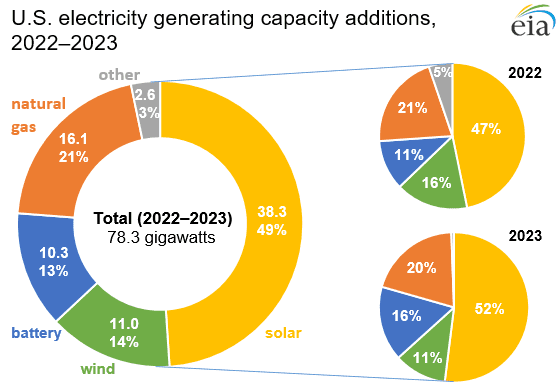Solar+Storage Will Lead New U.S. Generation Capacity

Solar power paired with energy storage is expected to lead capacity additions in the U.S. power generation sector over the next two years, according to the latest Electric Monthly Update from the U.S. Energy Information Administration (EIA).
The EIA in its December report, which includes data through October 2021, said it projects the U.S. will add about 78 GW of new electricity generation capacity in 2022 through year-end 2023. The agency said 62% of that total, or about 49 GW (Figure 1), will come from large-scale solar power and energy storage projects.
At least part of that capacity is expected to be eligible for the federal Investment Tax Credit, which was extended to 26% for this year and 2022. It will fall to 22% for projects in the 2023 timeframe, before dropping to 10% in 2024 and subsequently phasing down.
Energy analysts have said solar power should benefit from a number of policies enacted by governments worldwide in support of renewable energy, after the sector-like many others-saw some projects slowed by the coronavirus pandemic.
 1. The U.S. Energy Information Administration (EIA) expects more than 78 GW of new power generation capacity to come online across the country over the next two years, with solar power paired with energy storage leading the way. Source: EIA
1. The U.S. Energy Information Administration (EIA) expects more than 78 GW of new power generation capacity to come online across the country over the next two years, with solar power paired with energy storage leading the way. Source: EIATo meet global renewable targets and conquer climate change, solar PV [photovoltaic] needs a dramatic acceleration in deployment rates," said Phillip Klemm, CEO at Ideematec, a solar power equipment manufacturer. Klemm told POWER that A combination of improved financing options, preventive measures to cap carbon production, streamlined permitting systems in key growth markets, and technological advancements to speed installation times, and government support to spur innovation in reliable and efficient long-term energy storage options, could give our industry the needed extra push."
Battery Energy StorageEIA in its report said battery energy storage will add about 10 GW of capacity over the next two years, with more than 60% of that total likely co-located with solar power projects. The agency said 1.5 GW of battery storage was installed in 2020, and the EIA estimates 4.5 GW of new capacity will have been installed in 2021. The agency credits lower prices for batteries, along with the favorable economics of storage when deployed along with solar power, for much of that growth. The EIA also said solar-plus-storage is adding value as it provides grid flexibility and provides more resilience for electricity producers.
Storage technologies will continue to experience significant improvements in both economics and longer-term usability, beyond load shifting," said Klemm, who noted that technology advancements in solar power equipment are supporting the sector by improving both efficiency and ultimately project economics, with faster construction times and better maintenance. Trackers become smarter by the year and more effective-critical for optimizing solar generation," Klemm said. We've found ways to streamline installation times ... [and] module cost efficiencies are still improving as well."
California, Texas Lead New InstallationsThe EIA said three states will account for just more than half of the expected 49 GW of new solar-plus-storage projects over the next years, led by California with 11 GW. Texas is expected to add 10 GW of capacity; New York is expected to install an additional 4 GW.
 2. This chart from the U.S. Energy Information Administration (EIA) shows the breakdown of planned generating capacity additions over the next two years, compared to the generation added annually by fuel type over the past decade. Source: EIA
2. This chart from the U.S. Energy Information Administration (EIA) shows the breakdown of planned generating capacity additions over the next two years, compared to the generation added annually by fuel type over the past decade. Source: EIAWind power installations across the U.S. are expected to add about 11 GW of new generation capacity over the next two years, which the EIA characterized as a considerable decrease from the prior two years." The agency said it expects natural gas-fueled generation will account for 16 GW of new capacity, though wind and solar combined [Figure 2] are estimated to add about three times more new generating capacity than natural gas during this time period."
The agency, while noting the U.S. is not adding new coal-fired generation capacity, in a recent report said it expects electricity output from coal plants will end 2021 about 22% higher than in 2020, in large part due to higher prices for natural gas that spurred the burning of more coal. The EIA said 2021 marks the first year since 2014 with a year-over-year jump in coal-fired generation.
-Darrell Proctor is a senior associate editor for POWER (@POWERmagazine).
The post Solar+Storage Will Lead New U.S. Generation Capacity appeared first on POWER Magazine.